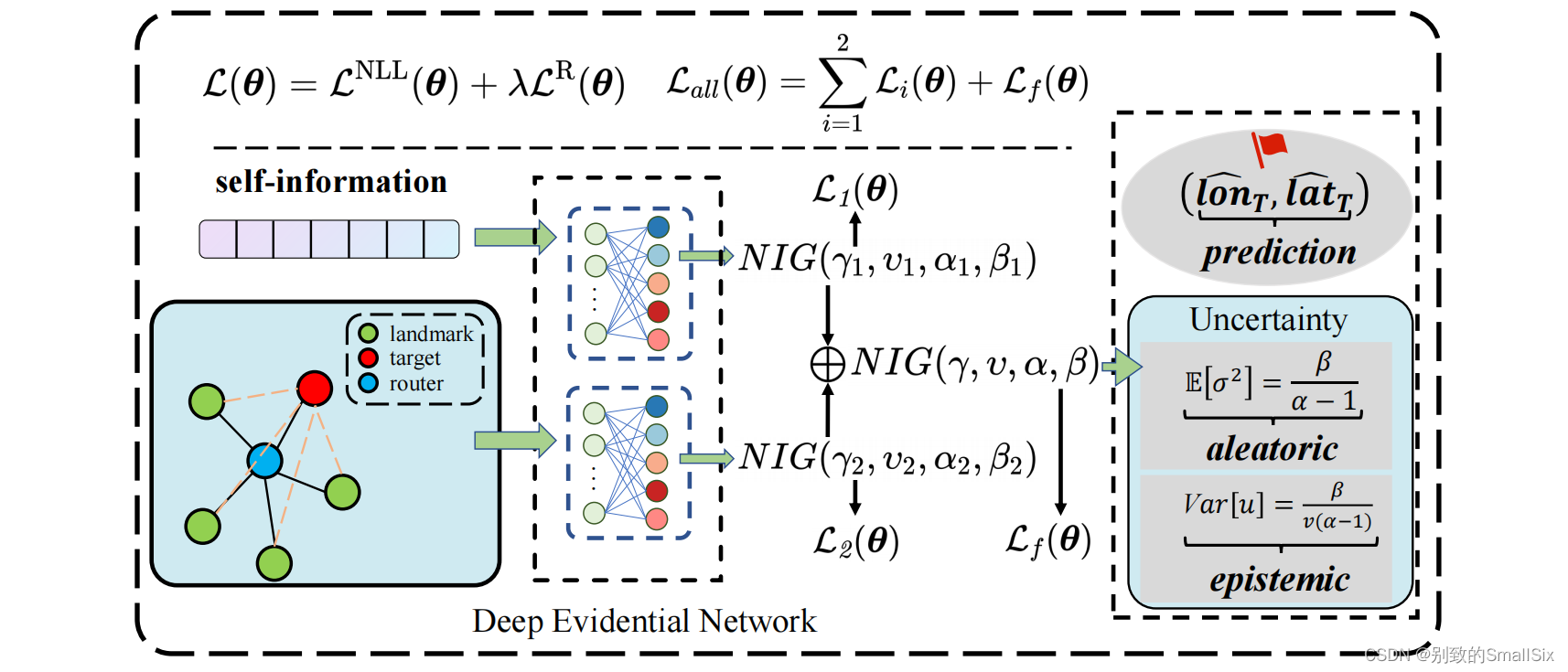
代码链接:https://github.com/ICDM-UESTC/TrustGeo
一、导入各种模块和神经网络类
from math import gamma
from re import L
from .layers import *
import torch
import torch.nn as nn
import torch.nn.functional as Func
import numpy as np这段代码是一个 Python 模块,包含了一些导入语句和定义了一个神经网络模型的类。
1、from math import gamma:导入了 gamma 函数,这是 Python 标准库中 math 模块中的一个函数,用于计算伽玛函数。
2、from re import L:导入了 L,这看起来是一个导入错误。通常来说,应该是导入正则表达式相关的模块,比如 import re。不过,这行可能是一个错误,可能需要修改。(好像没什么用)
3、from .layers import *:导入了当前模块所在目录中的 layers 模块中的所有内容。* 表示导入所有的内容。
4、import torch:导入了 PyTorch 库中的相关模块。torch 是主要的 PyTorch 模块。
5、import torch.nn as nn:导入了 PyTorch 库中的相关模块。tnn 包含了神经网络的构建块。
6、import torch.nn.functional as Func:导入了 PyTorch 库中的相关模块。functional 模块包含了一些与神经网络相关的函数。
7、import numpy as np:导入了 NumPy 库,NumPy 是一个用于科学计算的 Python 库,提供了大量用于数组操作的函数。
二、TrustGeo类定义(NN模型)
class TrustGeo(nn.Module):def __init__(self, dim_in):super(TrustGeo, self).__init__()self.dim_in = dim_inself.dim_z = dim_in + 2# TrustGeoself.att_attribute = SimpleAttention(temperature=self.dim_z ** 0.5,d_q_in=self.dim_in,d_k_in=self.dim_in,d_v_in=self.dim_in + 2,d_q_out=self.dim_z,d_k_out=self.dim_z,d_v_out=self.dim_z)# calculate Aself.gamma_1 = nn.Parameter(torch.ones(1, 1))self.gamma_2 = nn.Parameter(torch.ones(1, 1))self.gamma_3 = nn.Parameter(torch.ones(1, 1))self.alpha = nn.Parameter(torch.ones(1, 1))self.beta = nn.Parameter(torch.zeros(1, 1))# transform in Graphself.w_1 = nn.Linear(self.dim_in + 2, self.dim_in + 2)self.w_2 = nn.Linear(self.dim_in + 2, self.dim_in + 2)# higher-order evidence# graph view self.out_layer_graph_view = nn.Linear(self.dim_z*2, 5)# attribute view self.out_layer_attri_view = nn.Linear(self.dim_in, 5)# for output mu, v, alpha, betadef evidence(self, x):return Func.softplus(x)def trans(self, gamma1, gamma2, logv, logalpha, logbeta):v = self.evidence(logv)alpha = self.evidence(logalpha) + 1beta = self.evidence(logbeta)return gamma1, gamma2, v, alpha, betadef forward(self, lm_X, lm_Y, tg_X, tg_Y, lm_delay, tg_delay, add_noise=0):""":param lm_X: feature of landmarks [..., 30]: 14 attribute + 16 measurement:param lm_Y: location of landmarks [..., 2]: longitude + latitude:param tg_X: feature of targets [..., 30]:param tg_Y: location of targets [..., 2]:param lm_delay: delay from landmark to the common router [..., 1]:param tg_delay: delay from target to the common router [..., 1]:return:"""N1 = lm_Y.size(0)N2 = tg_Y.size(0)ones = torch.ones(N1 + N2 + 1).cuda()lm_feature = torch.cat((lm_X, lm_Y), dim=1)tg_feature_0 = torch.cat((tg_X, torch.zeros(N2, 2).cuda()), dim=1)router_0 = torch.mean(lm_feature, dim=0, keepdim=True)all_feature_0 = torch.cat((lm_feature, tg_feature_0, router_0), dim=0)'''star-GNNproperties:1. single directed graph: feature of <landmarks> will never be updated.2. the target IP will receive from surrounding landmarks from two ways: (1) attribute similarity-based one-hop propagation;(2) delay measurement-based two-hop propagation via the common router;'''# GNN-step 1adj_matrix_0 = torch.diag(ones)# star connections (measurement)delay_score = torch.exp(-self.gamma_1 * (self.alpha * lm_delay + self.beta))rou2tar_score_0 = torch.exp(-self.gamma_2 * (self.alpha * tg_delay + self.beta)).reshape(N2)# satellite connections (feature)_, attribute_score = self.att_attribute(tg_X, lm_X, lm_feature)attribute_score = torch.exp(attribute_score)adj_matrix_0[N1:N1 + N2, :N1] = attribute_scoreadj_matrix_0[-1, :N1] = delay_scoreadj_matrix_0[N1:N1 + N2:, -1] = rou2tar_score_0degree_0 = torch.sum(adj_matrix_0, dim=1)degree_reverse_0 = 1.0 / degree_0degree_matrix_reverse_0 = torch.diag(degree_reverse_0)degree_mul_adj_0 = degree_matrix_reverse_0 @ adj_matrix_0step_1_all_feature = self.w_1(degree_mul_adj_0 @ all_feature_0)tg_feature_1 = step_1_all_feature[N1:N1 + N2, :]router_1 = step_1_all_feature[-1, :].reshape(1, -1)# GNN-step 2adj_matrix_1 = torch.diag(ones)rou2tar_score_1 = torch.exp(-self.gamma_3 * (self.alpha * tg_delay + self.beta)).reshape(N2)adj_matrix_1[N1:N1 + N2:, -1] = rou2tar_score_1all_feature_1 = torch.cat((lm_feature, tg_feature_1, router_1), dim=0)degree_1 = torch.sum(adj_matrix_1, dim=1)degree_reverse_1 = 1.0 / degree_1degree_matrix_reverse_1 = torch.diag(degree_reverse_1)degree_mul_adj_1 = degree_matrix_reverse_1 @ adj_matrix_1step_2_all_feature = self.w_2(degree_mul_adj_1 @ all_feature_1)tg_feature_2 = step_2_all_feature[N1:N1 + N2, :]# graph viewtg_feature_graph_view = torch.cat((tg_feature_1,tg_feature_2), dim=-1)# attribute view (for shanghai dim=51) tg_feature_attribute_view = tg_X'''predict'''output1 = self.out_layer_graph_view(tg_feature_graph_view)gamma1_g, gamma2_g, v_g, alpha_g, beta_g = torch.split(output1, 1, dim=-1)# attributeoutput2 = self.out_layer_attri_view(tg_feature_attribute_view)gamma1_a, gamma2_a, v_a, alpha_a, beta_a = torch.split(output2, 1, dim=-1)# transform, let v>0, aplha>1, beta>0 gamma1_g, gamma2_g, v_g, alpha_g, beta_g = self.trans(gamma1_g, gamma2_g, v_g, alpha_g, beta_g)gamma1_a, gamma2_a, v_a, alpha_a, beta_a = self.trans(gamma1_a, gamma2_a, v_a, alpha_a, beta_a)two_gamma_g = torch.cat((gamma1_g, gamma2_g), dim=1)two_gamma_a = torch.cat((gamma1_a, gamma2_a), dim=1)return two_gamma_g, v_g, alpha_g, beta_g, \two_gamma_a, v_a, alpha_a, beta_a这是一个 PyTorch 中神经网络模型的类定义,它继承自 nn.Module 类,表明这个类是一个 PyTorch 模型。
分为几个部分展开描述:
(一)__init__()
def __init__(self, dim_in):super(TrustGeo, self).__init__()self.dim_in = dim_inself.dim_z = dim_in + 2# TrustGeoself.att_attribute = SimpleAttention(temperature=self.dim_z ** 0.5,d_q_in=self.dim_in,d_k_in=self.dim_in,d_v_in=self.dim_in + 2,d_q_out=self.dim_z,d_k_out=self.dim_z,d_v_out=self.dim_z)# calculate A


)

)






)



——树和二叉树的概念)

)
)